
Huntsman spiders, members of the family Sparassidae, are known by this name because of their speed and mode of hunting. They are also called giant crab spiders because of their size and appearance. Larger species sometimes are referred to as wood spiders, because of their preference for woody places. In southern Africa the genus Palystes are known as rain spiders or lizard-eating spiders. Commonly they are confused with baboon spiders from the Mygalomorphae infraorder, which are not closely related.
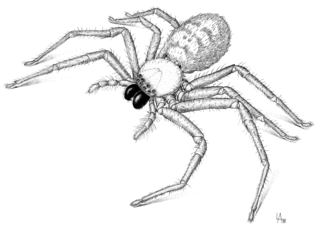
Delena cancerides, the flat huntsman or social huntsman or Avondale spider, is a large, brown huntsman spider native to Australia. It has been introduced to New Zealand, where it is sometimes known as the Avondale spider as they are commonly found in the suburb of Avondale, Auckland. This was the species used in the beginning of the 2002 movie Spider-Man, a part in Australian movie Napoleon and widely in Arachnophobia, and all films depict them as having a deadly venomous bite, but they are generally considered harmless to humans in real-life. It was first described by Charles Athanase Walckenaer in 1837.

Micrommata is a genus of huntsman spiders that was first described by Pierre André Latreille in 1804.

Micrommata virescens, common name green huntsman spider, is a species of huntsman spiders belonging to the family Sparassidae.
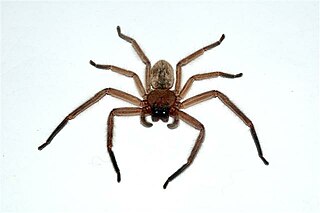
Delena is a genus of South Pacific huntsman spiders that was first described by Charles Athanase Walckenaer in 1837.
Damastes is a genus of East African huntsman spiders that was first described by Eugène Louis Simon in 1880. It is classified under the family Sparassidae, though its subfamilial classification remains unclear. The subspecies Damastes coquereli affinis is a nomen dubium.
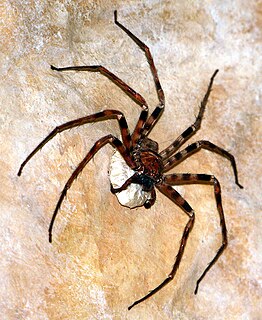
The giant huntsman spider is a species of the huntsman spider family Sparassidae found in Laos. It is considered the world's largest spider by leg span, which can reach up to 30 cm (1 ft).
David B. Hirst is an arachnologist previously based at the South Australian Museum in Adelaide. He left the Museum on 22 February 2011. He has described more than 40 species and genera in the huntsman spider family, Sparassidae, and was regularly called on by New Zealand authorities to identify huntsman spiders that entered their country.
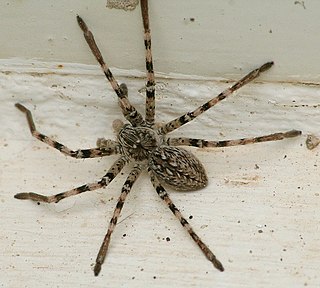
Eusparassus is a genus of huntsman spiders that was first described by Eugène Louis Simon in 1903.
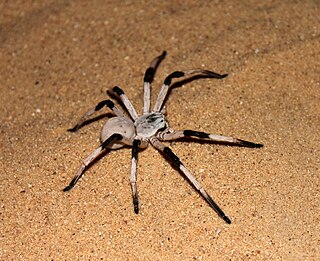
Cerbalus is a genus of huntsman spiders that was first described by Eugène Louis Simon in 1897. It is considered a senior synonym of Marmarica.

Isopeda is a genus of huntsman spiders that was first described by Ludwig Carl Christian Koch in 1875.

Cebrennus is a genus of huntsman spiders that was first described by Eugène Louis Simon in 1880. It is considered a senior synonym of Cerbalopsis.
Pleorotus was a monotypic genus of Seychelloise huntsman spiders containing the single species, Pleorotus braueri. It was first described by Eugène Louis Simon in 1898, and was endemic to the Seychelles. The description was based on a single male collected on Mahe Island in 1894, but none have been found in later collections, and it has been declared extinct.
Caayguara is a genus of Brazilian huntsman spiders that was first described by C. A. Rheims in 2010.
Guadana is a genus of South American huntsman spiders that was first described by C. A. Rheims in 2010.
Martensopoda is a genus of Indian huntsman spiders that was first described by Peter Jäger in 2006. As of September 2019 it contains three species, found in India: M. minuscula, M. sanctor, and M. transversa.
Nisueta is a genus of East African huntsman spiders that was first described by Eugène Louis Simon in 1880.
Sivalicus is a monotypic genus of Indian huntsman spiders containing the single species, Sivalicus viridis. It was first described by S. Dyal in 1957, and is found in India.
Sparianthis is a monotypic genus of Colombian huntsman spiders containing the single species, Sparianthis granadensis. It was first described by Eugène Louis Simon in 1880, and is found in Colombia.
Uaiuara is a genus of huntsman spiders that was first described by C. Rheims in 2013.









